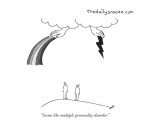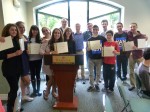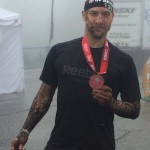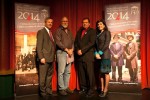For more cartoons, visit thedailysnooze.com.
Images
Evidence for and against pot
Standing, from left to right, are panel facilitator Michael Levy, CFHU board member Stav Adler, Rabbi Andrew Rosenblatt, Prof. Raphael Mechoulam and Dr. Kathryn Selby. (photo by Michelle Dodek)
It may be a common occurrence in many parts of the city, but it is still a rare thing to pass through marijuana smoke while entering an Orthodox synagogue. But that was the case on June 24, when a panel discussion took place at Schara Tzedeck on the topic Should I Change My Mind About Weed? A small number of attendees, unsatisfied with a merely academic consideration of the topic, opted for a more psychoactive engagement.
The director of the local Canadian Friends of the Hebrew University, Dina Wachtel, was inspired to convene a panel on marijuana after watching Dr. Sanjay Gupta’s CNN documentary on the topic.
Prof. Raphael Mechoulam, a Hebrew University chemist and a leading expert on the subject, said that marijuana has been used in societies from India and China to the Middle East “forever.” Queen Victoria’s doctor, J. Russell Reynolds, used it to treat the queen’s migraines.
Mechoulam said that cannabidiol (CBD), a component in marijuana, may have medical uses “in almost all diseases affecting humans.” Unlike tetrahydrocannabinol (THC), the component that causes a high, CBD does not deliver a high and has no known side effects. However, there have been almost no clinical trials on humans, probably because pharmaceutical corporations would not be able to patent it and governments, for various reasons, have avoided the matter.
Cannabinoid receptors are abundant in multiple brain regions, he said, including those affecting movement control, learning and memory, stress, cognitive function and links between cerebral hemispheres. Marijuana can impact appetite, blood pressure, cerebral blood flow, the immune system and inflammation.
In tests on mammals, such as mice, marijuana reduced brain trauma and reduced or eliminated cancerous tumors. There was a clinical trial on its use around epilepsy and its effect on patients experiencing 10 to 30 seizures per day. Cannabinoids were tested on people for whom existing drugs do not work and resulted in positive outcomes in large numbers of adult patients. “This is the only clinical trial that has ever been reported – 35 years ago,” he said.
Infants undergoing cancer treatment that causes vomiting were given small amounts of THC. “We saw a complete stop of all vomiting and nausea,” with no side effects, he said.
In treatment of schizophrenia, current drugs have some extremely unpleasant side effects, he noted, while CBD has none. Even so, in most jurisdictions, marijuana is in the same legal category as heroin.
Dr. Kathryn Selby, a clinical professor in the University of British Columbia’s pediatrics department specializing in developmental neurosciences, spoke on marijuana’s effect on the adolescent brain. She spoke of the “enormous plasticity of the teen brain” and said that THC can alter the brain’s structure and function, and that the neurotoxic effects can be lifelong. Maturing of the human brain continues into the 20s, she explained, and the prefrontal cortex, which involves judgment and executive functions, develops last. There are two peaks in brain maturation and cerebral volume, happening in early childhood and then, for boys, at age 14-and-a-half and, for girls, at 11-and-a-half. Trauma, stress, substance abuse and sedentary habits can negatively affect development.
The effects of marijuana use in the short term can be loss of motivation, fatigue and, in about 10 percent of users, addiction. Neuroimaging indicates that the longer-term impact of marijuana use by adolescents is strongly associated with psychoses such as schizophrenia later in life. Selby said there is a 40 percent increase in prevalence of psychosis among users, with a 50 to 200 percent increase in psychoses among heavy users and, among those who use marijuana daily during high school, there is a 600 percent increase in depression and anxiety later in life. Correlations also include lowered IQ, intellectual and emotional issues.
The frontal lobe, which is not completely formed by adolescence, is also the most affected by alcohol and drugs and leaves users vulnerable to the “adverse developmental, cognitive, psychiatric and addictive effects of marijuana.” Selby recommended that, if marijuana is used at all, that it be “as late and as little as possible.”
Rabbi Andrew Rosenblatt, Schara Tzedeck Synagogue’s spiritual leader, also has a biochemistry degree. Although the Torah does not say anything specifically about marijuana, Rosenblatt made the comparison to what the Torah and Talmud say about other forms of altered states, particularly drunkenness. If there were any questions about the severity of potential outcomes from inebriation, Rosenblatt said, the drunkenness and castration of Noah is a cautionary tale.
Rosenblatt also mentioned the story of Lot, whose daughters got him drunk and seduced him, resulting in Amnon and Moab, who were both Lot’s sons and grandsons. Rosenblatt cited it as an indication that drunkenness and disinhibition is to be avoided.
The holiday of Purim is of particular interest in this discussion and Rosenblatt said there is a modern interpretation of the old dictum that Jews should become so drunk on Purim that they cannot tell the difference between the names of the villain Haman and the hero Mordechai. The modern view, the rabbi said, is to drink a little, get tired, fall asleep and, when asked who is Haman and who is Mordechai, to roll over and snore.
Rabbis in recent years have overwhelmingly concurred that use of, say, morphine for terminal patients is justified, but the use of untested alternative measures is not.
“Anecdotal evidence is anecdotal evidence,” said Rosenblatt. If studies indicate that marijuana were clinically proven to assist in recovery or treatment for various diseases, he said, it would almost certainly become acceptable.
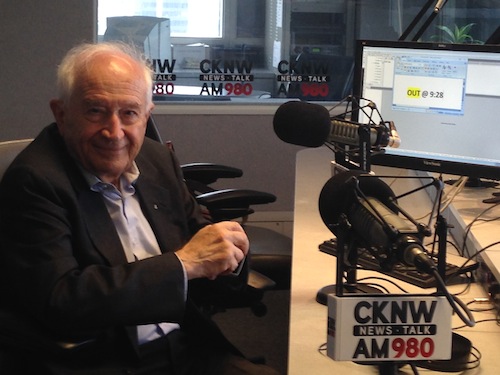
The panel was moderated by Michael Levy, CKNW radio and Global TV personality. Stav Adler, president of CFHU Vancouver chapter, introduced the evening. Hodie Kahn, president of Schara Tzedeck, invited the audience to stay around for munchies after the event.
Were minds changed? After Mechoulam’s presentation, he received an enthusiastic standing ovation from about half the audience of 200 or so. After her presentation, Selby was greeted with polite applause, while one man jumped to his feet.
Pat Johnson is a Vancouver writer and principal in PRsuasiveMedia.com.
Through blues to happiness with Jill Newman
Jill Newman at Cottage Bistro May 9 singing from her new CD, Lovestruck Blues. (photo by John Endo Greenaway)
Happiness. Perhaps ironically, Jill Newman’s performance at the release party for her latest CD, Lovestruck Blues, exuded happiness. The May 9 show at Cottage Bistro featured bright vocals, skilful (and electric) electric-guitar playing, cheerful interactions with the audience and a playlist of well-written, original songs, many about finding love, but also about losing it – even these, though, exhibit optimism, finding the courage and strength to be on one’s own and true to one’s heart.
Newman’s talents as a songwriter and musician were obvious in her debut recording, Fragile Walls, in 2004. The review in the Independent (“A garden of musical delights,” April 22, 2005) ended with the comment, “It’s been a long road for Newman to reach this creative milestone. Hopefully, it’s the first of many.” A decade later, Lovestruck Blues is another welcome milestone – and there’s nothing fragile about it. It exhibits the confidence and contentment of someone who has, so to speak, come out the other side. As Newman writes in the CD booklet, “It is the story of my journey – of turning my world upside down, taking some risks and being blissfully happy for having done so.”
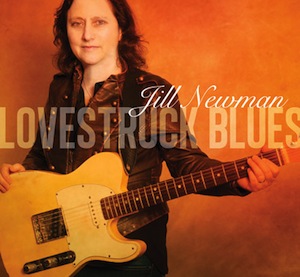
During the period between releases, Newman told the Independent, a lot changed for her personally and musically. “My first CD was the culmination of many years of dreaming of making my own recordings,” she explained. “I was going through a difficult time in my life, including a breakup, so the songs were really all about loss and heartbreak. I had a great producer who took care of almost everything for me, from arranging the songs to organizing and directing the entire recording process.
“Today, I’m in a much better place personally, having just gotten married a few years ago and feeling happy. That does present some challenges for writing the blues – as lately I’ve been writing happy blues songs. I produced Lovestruck Blues myself with support from my engineer, Marc L’Esperance. I made all the final decisions in terms of how I wanted the recording to sound and directed the recording sessions in Seattle and Vancouver. I was not going for a retro sound, but that’s really what comes out. I’ve played in everything from country, punk, blues and even an all-female Led Zeppelin tribute band, so I’m quite eclectic in my approach to music. I’m often told that my music should be in soundtracks for Quentin Tarantino’s films, the less happy songs, that is.
“I’m most at home in front of a live audience rather than in the studio, as I really enjoy the energy and the interaction between the audience and the band,” she added. “I’ve been doing lots of performances and my live shows are definitely stronger than they were 10 years ago. I’ve also been doing quite a bit of vocal work over the past few years. Songwriting is always a challenge, with lots of hours spent struggling with lyrics – I still tend to write the music first or jointly with the words and then fine tune the lyrics.”
Lovestruck Blues includes 10 original songs, one of which – “Too Hard to Handle” – was co-written with Vancouver actor, artist, director, playwright and songwriter Lynna Goldhar Smith.
“I’m originally from Wisconsin, but immigrated to Vancouver Island with my family as a teen. I spent about 25 years living in the Vancouver area, with some brief stints in Washington,” said Newman about her community connections. “I was raised in a secular Jewish household with no religious upbringing, but I identify culturally as Jewish. My most valued connection to the Jewish community was my past involvement with the Peretz Centre for Secular Jewish Culture. My daughter, Michelle, participated as a young teen in the b’nai mitzvah program, which was a great experience for both of us. I also enjoyed singing in the Jewish Folk Choir and participating in the Peretz programming.
“I’ve worked for Jewish Family Service Agency in Vancouver and in Seattle and participated in advocacy to address poverty in the Jewish community in Vancouver. I combine my work as a professional guitarist, singer and songwriter with my part-time work as a therapist with teens who are struggling with mental health issues. When I have spare time, I enjoy being in the outdoors kayaking or sailing.”
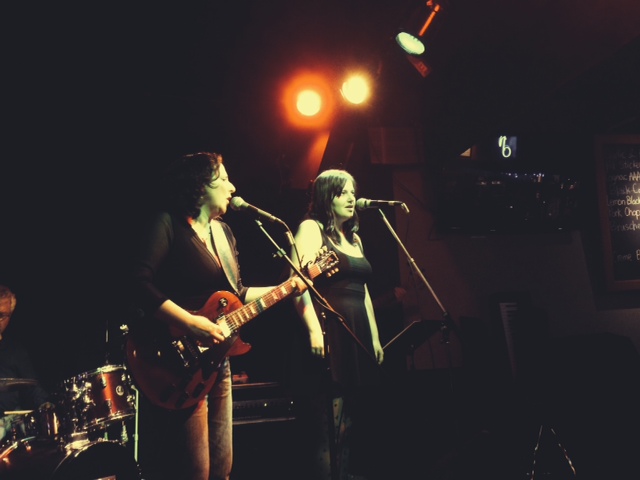
A woman with many abilities and interests, Newman’s musical path also started somewhere other than where it led.
“I started in music playing classical flute at age 9 and got involved in community symphony and jazz combos as I got older, with a stint studying jazz in college,” she told the Independent. “My first stringed instrument was the banjo, followed by the acoustic guitar and pedal steel [guitar], but when I first plugged in an electric guitar (Stratocaster copy) at age 15, I was totally hooked. I loved the sound and the power of the electric guitar, especially turned up loud with distortion. A friend who’d been in rock bands taught me how to bend the strings properly and I began specializing in playing lead guitar – something very few girls were doing when I was a teen.
“I played constantly and learned everything I could figure out by Heart, Aerosmith, Yes and Led Zeppelin, but I also started writing my own songs and performing in coffeehouses. By my early 20s, I was making a living as a full-time professional guitarist and, other than recovering from a hand injury, I’ve never stopped playing. I feel strongly that we need more female electric guitarist role models and I volunteered as a guitar instructor for Vancouver Girls Rock Camp in 2012.”
And what draws Newman to the blues? “It’s the raw emotion and the simplicity of the music that grabs me,” she said, reiterating, “I’ve had a longstanding love of the electric guitar and, when I first began listening to blues players like Freddie King and Eric Clapton, I was blown away by the expressiveness of their playing. In recent years, I’ve been focusing a lot on slide guitar, which has a range of expression that emulates the human voice and beyond. There’s nothing more soulful than Roy Rogers playing slide guitar on Elmore James’ song ‘The Sky is Crying,’ or almost anything by Ry Cooder or Derek Trucks.”
Part of the fun of the Cottage Bistro CD release party – in which she was accompanied on stage by Loren Etkin on drums and Brian Scott on bass – was the seemingly spontaneous invitation by
Newman for her daughter, Michelle Baynton, and Cecile Larochelle to join her in a couple of the songs they each performed with Newman on Lovestruck Blues.
“One of the things that was the most special about making this new CD,” Newman admitted, “was getting a chance to record with my daughter, Michelle. She’s just finishing her opera degree at UBC and, despite my doing a very different style of music, we get a lovely vocal blend together. Michelle sang background vocals on my songs, ‘Everything Will Change’ and ‘Without You.’”
Newman, along with Etkin and Cameron Hood (bass), will perform next on July 14, 9 p.m., at Guilt & Co., 1 Alexander St., in Vancouver. For other upcoming performances, keep an eye on jillnewman.net, sign up to receive email updates or like the Jill Newman Blues Facebook page.
This week’s cartoon … July 4/14
For more cartoons, visit thedailysnooze.com.
Melanie Fogell’s paintings inspire imagination
Melanie Fogell’s paintings inspired the story told here. (photo by Olga Livshin)
The solo show Illuminated Forests by Melanie Fogell is on display at the Sidney and Gertrude Zack Gallery until July 27. As I wandered through the gallery, surrounded by Fogell’s paintings, I felt as if I were in a varicolored forest, alive with stories. Stories grew between the majestic trees, flitted among the rustling leaves and dozed under the evergreens.
***
Tia guided her wheelchair into the park. The dappled leaves whispered above her head, green and pink and pretty, smelling of sunlight. She resented them. Nothing should be that beautiful, while she was stuck in this ugly chair. After a single brief glance around, she stared sullenly ahead, into the shimmering, fragrant air. She found it oppressive. An hour outside, as the doctor prescribed, and she would head back home, into her room, where no beautiful things waited.
A gasp to her left caused her finger to jerk on the control stick, and her chair lurched forward. No matter how she detested the forest’s loveliness, she didn’t want to run anyone down. When she stopped and looked for the source of the noise, she saw an old woman in a wheelchair. The woman’s silver hair surrounded a pale wrinkled face like snowy lace.
“Hi,” the woman said. “You startled me, dear. How romantic. Two wheelchairs meeting in a park. Almost a love story.” She smiled.
“Nothing romantic,” Tia blurted. “And nothing to smile about. Definitely not a love story.” Tears sprang up, despite her attempt to suppress them. “Stupid,” she muttered, her fingers tightening on the controller.
“Don’t go,” the woman said. “It’s lonely here. Would you tell me about yourself? Was it an accident? I’m Alice.”
“I’m Tia.” Tia nodded stiffly. Alice looked truly interested. Why not? She had to kill the next hour anyway. She started talking. She was in a car, with her friend driving, and a drunk driver rammed his van into them.
Both her friend and the drunken jerk ended up dead, leaving her alive to deal with mangled legs.
“They are broken in a gazillion places.” She kept a sob inside by sheer willpower. “I was a dancer. Now, I’m … a cripple. The doctor said I might walk again, eventually, after another surgery. I’ll probably always limp. No dancing for sure.” This time, a sob escaped.
“So, you got lucky,” Alice said calmly. “You survived.”
“Lucky, ha!” Tia swore loudly, daring Alice to disapprove. She would never have said anything so rude before her accident, but now, she didn’t care. Rudeness even made a perverted sense. It helped her not to cry.
Alice nodded. “Good idea.” Then, she too swore, very creatively. “The trees absorb our anger and hurts,” she said. “They heal us. With obscenities, we pour out our pain, bury it. It’s like verbal manure.”
Surprised, Tia laughed. “You think so?”
“Yes. Now, inhale the sweet air. Take in the goodness.” Alice looked expectant, waiting.
Tia shrugged. Inhaled. Alice was right, the forest smelled good. It smelled of living things, of dreams.
“Now swear again,” Alice said. “Repeat after me.” The following string of descriptive verbal abuse made Tia laugh aloud for the first time since the accident. She dutifully repeated the words, wincing only a little.
“Well, dear. Do you feel better? I have to go back now, so I’ll have to turn here, at this intersection, but we’ll meet again, right?” She reversed her chair and met Tia’s eyes. “I hope you’ll walk soon. Bye, Tia.” Alice brushed her thin fingers across Tia’s hand, and then rolled away into the gold and green mosaic of the foliage, vanishing behind a bend in the greenery. The lower branches swayed in her wake, a bird trilled overhead.
“Bye, Alice,” Tia said. She did feel better. Only later, after returning home, she realized that she didn’t even thank Alice.
She visited the park every day afterwards, watching the trees and the light change with the season, feeling her pain draining away. She never met Alice again. The next surgery went well, and she healed quickly. After a couple months of grueling physiotherapy, she started limping on her own feet. The doctor said the limp would fade in time. No dancing, of course, but walking felt good. She would find Alice and say thank you.
The autumn forest overflowed with color, reds and greens and yellows of every shade. The fallen leaves bounced under her shoes. Alice would love it, she thought. But when Tia entered the nursing home on the other side of the park, Alice wasn’t there.
“She died in the spring,” said the receptionist. “Are you Tia?”
“Yes,” Tia breathed.
“She left something for you. She was an artist.”
It was a small painting, a forest in spring: leaves and sunlight embracing each other in a quiet melody of green and amber and peach, singing of hope.
Olga Livshin is a Vancouver freelance writer. She can be reached at [email protected].
ISIS looking to Jordan
An Israeli border policeman patrols the area of the Judean desert, near the Jordan border. After swift victories in Iraq, the Islamic State in Iraq and Greater Syria (ISIS) terrorist group is setting its sights on Jordan, threatening to drag Israel into the global jihadist conflict. (photo by Nati Shohat/FLASH90)
Emerging from the chaos of the Syrian civil war, the Islamic State in Iraq and Syria (ISIS) terrorist group has gained the world’s attention for its brutal medieval-style justice and its swift victories in Iraq, threatening to overrun the weak U.S.-backed government there. But now ISIS is also setting its sights on Jordan, threatening to drag Israel into the global jihadist conflict.
“They are a vicious and brutal group, and have even done some things that al-Qaeda thought were unwise,” Elliot Abrams, who served as deputy national security advisor for former President George W. Bush and is currently a senior fellow at the Council on Foreign Relations, told this reporter. “More people, more money and more guns. They do constitute a real threat.”
The goals of ISIS are clear from its name. Alternatively translated as the Islamic State in Iraq and al-Sham (the Arabic name for the Levant region) or the Islamic State in Iraq and the Levant (ISIL), the group seeks to control the entire region, which, in addition to Iraq and Syria, includes Jordan, Lebanon, and even Israel and the Palestinian territories.
NCSY Vancouver celebrates organization’s 60 years
Graduates of NCSY’s Impact leadership program at the spring regional awards banquet in Harrison Hot Springs, with Rabbi Samuel Ross. (photo from Rabbi Samuel Ross)
In a Jewish community with one of the highest assimilation rates, the role of youth groups such as the Vancouver chapter of the National Conference of Synagogue Youth (NCSY) has become more important over the years. NCSY Vancouver’s parent organization was founded in 1954 and the local chapter, which emerged about a decade later, is helping celebrate the 60th anniversary milestone.
NCSY works to develop a connection with Jewish youth before they embark on their university and professional lives. Rabbi Samuel Ross, NCSY Vancouver director, spoke about the “unique, beautiful situation” in which the chapter works. He said they “cater to anyone and everyone, which is an ongoing challenge but it’s really reaping rewards.” Indeed, many of those who join or take part in NCSY activities develop lifelong connections to Judaism and Israel, which was Nicole Grubner’s experience.
Grubner grew up in West Vancouver and became involved with NCSY when she was in Grade 9. She started attending their Shabbatons, and loved the warm atmosphere and Jewish connection that she felt at these events. By the end of high school, she was on the NCSY student leadership board, began keeping Shabbat, and had signed up for a post-graduate year at a seminary in Israel.
“I think the goal of NCSY is for it to be a jumping off point for you, so I used it as that and continued my Jewish education after high school,” said Grubner, 25. “It brought a lot of meaning into my life and week and I enjoyed the sense of community that it brought.”
NCSY Vancouver hosts a mix of educational and social programs, everything from a mock casino night to sushi in the sukkah to Shabbatons, trips and leadership programs.
“The city is growing, the chapter is exploding, I wouldn’t want to be anywhere else. I’m actually bringing in someone else to come work for me next year,” said Ross, who has been leading NCSY Vancouver for the past three years. “We do the best we can to inspire them enough so that they’ll want to continue their Jewish growth once they get to university.”
In Grubner’s case, after her year in Israel, she studied at Stern College in New York, returning to Israel every year.
“I actually went back to NCSY and staffed summer programs in Israel for three years,” she said. “I had an amazing Israel experience and it was important for me to give that to someone else.”
Her love of Israel and connecting with the Jewish people didn’t dampen after university ended. In October 2012, she made aliyah.
“In Vancouver, we know that assimilation is a really huge problem, so NCSY is really important to the Jewish community in Vancouver because it’s a connection point, one that many kids don’t get the opportunity to be a part of.”
“It had a very big impact on my life, so much so that I made my best friends and closest connections in NCSY. I’m really grateful for the base it gave me, for the fact that I was able to get so involved and so connected in high school,” she said. “In Vancouver, we know that assimilation is a really huge problem, so NCSY is really important to the Jewish community in Vancouver because it’s a connection point, one that many kids don’t get the opportunity to be a part of. NCSY has really changed the face of Vancouver’s Jewish community,” she said.
NCSY is a globally recognized organization that connects Jewish youth through social, recreational, educational and spiritual programs.
“It’s about connecting kids to their roots and to their Jewish identity. Whether kids become religious or not, to me, that’s almost less important than kids thinking about their Judaism and it being something important to them in whatever way they choose to practise,” said Grubner. “It shouldn’t be a part of their identity that passes them by because of apathy or lack of knowledge.”
In Vancouver, the number of Jewish youth involved in NCSY programming has been growing. This year, they’re sending 16 youth to programs in Israel. Some of their programs draw 100 kids, and there are already 25 applicants this year for the NCSY Vancouver youth board.
“When I first came three years ago, we had to beg kids to be on that board,” said Ross. “Now, it’s really hard to get on. The kids have to write an essay why they like NCSY and what they can add, and it’s beautiful. You see how they write how Judaism has made such a difference in their lives and how passionate they are and how much they enjoy coming.”
Vicky Tobianah is a freelance writer and editor based in Toronto. Connect with her on Twitter, @vicktob, or at [email protected].
Community memorial for Eyal Yifrach, Gilad Shaar and Naftali Fraenkel
Eyal Yifrach, Gilad Sha’er and Naftali Fraenkel z”l (photo from mfa.gov.il)
On Monday, June 30, the bodies of Eyal Yifrach, 19, Gilad Shaar, 16, Naftali Fraenkel, 16, who were kidnapped June 12, were found northwest of Hebron. The sad discovery was the result of an extensive search effort led by the Israel Defence Forces, the Israel Security Agency and the Israel Police. A joint funeral was held July 1. Jewish groups and others around the world join in mourning.
In Vancouver, there will be a community memorial service, coordinated by the Rabbinical Association of Vancouver and led by Rabbi Berger, Rabbi Moskovitz and Cantor Szenes-Strauss, on Thursday, July 3, at the Jewish Community Centre of Greater Vancouver at 7:30 p.m.
As well, to share your thoughts and express your condolences to the families of the boys, visit the Jewish Federations of North America’s “Remember Our Boys” page.
Love to win? Or hate to lose?
Pursuing more of my “Love to Win” side at the 2014 Spartan Sprint obstacle race.
Call it ironic, but in my less-than-fit days I was a regular subscriber to Men’s Health magazine.
As I looked upon the cover of each fresh edition I sincerely believed (read: hoped) that this just might be the edition that unveils the ground-breaking discovery that Maple Walnut ice cream contained a fat-burning ingredient that could give me “six-pack abs by summer!”
I eventually decided to take a different route to improved fitness. While I can’t say I would credit Men’s Health for my success, there was one posting that left a long-lasting impression on me.
This specific article effectively split humanity into two simple groups.
Group 1: Those who love to win.
Group 2: Those who hate to lose.
Of course everyone prefers winning and, thus, would rather not lose. But most people, if they really think it through, can probably identify what fuels them more; the rush of victory or resentment toward loss.
It didn’t take me long to realize I was a hate-to-lose kind of dude. If my team, in any sport, was winning life seemed in order and under control. There was balance in the Force. But if we were losing my emotions would take over in an effort to avoid failure. I would walk away from any loss feeling frustrated, unsettled and pondering what I could have done to avoid it. I didn’t need to celebrate the wins as much as I needed to avoid the feeling of loss.
I embraced that discovery and used it to make me better. In hockey I became a defensive, shut-down centre, eventually turning to a pure defenseman where my emotional drive to avoid getting beat could feed my game. It proved to be a good move for my career (boy, do I use the word career lightly).
In the last couple of years, however, I considered if perhaps my friendship with the hate-to-lose side of me had led to complacency and, in some cases, boredom! (we’ll get to that nasty word in a later post)
Generally speaking, of course, hate-to-lose people might play the game of life a little on the safe side. They could miss out on hidden opportunities while choosing to avoid opportunities to test their limits. They are less likely to take risks or seek adventure. Their theory being, “If it ain’t broke, don’t fix it.”
The love-to-win type is ready to take those risks and fly by the seat of their pants for the possible thrill of success. On the flip side, they might take unnecessary risks, act without calculated consideration of consequence, risk losing a lot for the sake of winning a little. Their theory being, “Let’s break it ‘cause maybe we can rebuild it better.”
So which one is better? I could give you all sorts of analogies of how either approach has a proven track record of success.
But the key is to find out who you are and challenge yourself to bring the other element into your life a little more. I’ll use a hockey analogy (get used to it) to show you what I mean. It is commonly preached that “defense wins championships.” But it is also a fact that you can’t win the Stanley Cup without scoring goals. Even the defensemen need to contribute to the offense for a team to be a serious contender. More specifically, the great players who lead their teams to the big games are the ones who find the right balance of defense and offense. Those players aren’t born playing like that. They all enter the league with one style of play that has gotten them to where they are. Then they develop that balance over seasons of growth, experience and hard work. The most successful players develop their weaknesses to complement their strengths.
This is a concept we should all adopt for the sake of growth, inspiration and diversity. Whether you are more of a hate-to-lose or a love-to-win type, heighten your awareness to that and consider the areas of your life where a lack of balance has possibly challenged your growth or development. Then make the effort to approach the opposite way of thinking from time to time.
It worked for George Costanza!
Kyle Berger is a freelance writer and producer of the Berger With Fries health, fitness and entertainment blog. Follow him on Twitter @kberger16.
Celebrate Canada’s start in P.E.I.
From left to right, the Hon. Robert Henderson; Gary Schneider, Confederation Forest Project; John Horrelt, chair, PEI 2014 community advisory committee; and Penny Walsh McGuire, executive director, PEI 2014 Inc. (photo from pei2014.ca)
Prince Edward Island is where the idea of our country first took shape. On Sept. 1, 1864, the Charlottetown Conference brought together representatives of the Maritime colonies and the province of Canada (present-day Quebec and Ontario) and the “Fathers of Confederation” laid the groundwork for Confederation, which became reality on July 1, 1867.
This summer marks the 150th anniversary of that conference and the historic moment will be celebrated in what many consider to be the birthplace of Canada – Charlottetown, P.E.I. There will be more than 150 different festivals, events and activities in the province.
“P.E.I. is proud to have hosted such an important meeting in our nation’s history in 1864,” said Penny Walsh McGuire, executive director of PEI 2014, which is organizing the celebrations. “One hundred and fifty years later, Prince Edward Island is very proud to be playing host yet again – this time to all Canadians and visitors from around the world as we celebrate the creation of our nation.”
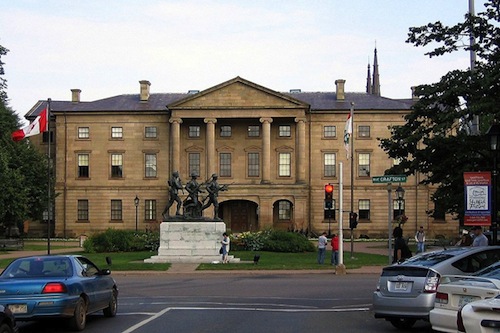
The 70 days of celebration, from July 1 until Sept. 7, feature daily concerts, theatre performances and comedy on the Atlantic Lottery/Red Shores Main Stage, cultural arts and heritage exhibits in the Canada Pavilion, chef demonstrations and local food tastings in the Culinary Pavilion, interactive activities in the Kids Pavilion, as well as historical walking tours.
While celebrating Prince Edward Island’s history, and our nation’s, it would be remiss to not also highlight the long history of the province’s small but strong Jewish community.
Prince Edward Island’s first Jewish settlers were recorded in a newspaper article about a celebration of Passover in 1908. The community grew very slowly, with only a dozen Jewish families reported as residing there before the Second World War. In the 1970s, a Torah scroll was brought to the island for the first time and there were the first recorded High Holiday services; 1976 marked the celebration of the first bar mitzvah there.
“Coming here for the first time was almost like coming to Israel the first time. I felt like I belonged,” said Leslee Sack, a New York native who moved to Prince Edward Island in 2007. She is now the secretary of the P.E.I. Jewish Community (PEIJC).
“This place is what Brooklyn was like in the ’50s,” she said. “Everyone wants to talk to you, everyone wants to know your story.”
For 40 years, Sacks worked as a travel agent in New York; her office was in a building across from the World Trade Centre. She wasn’t at work on Sept. 11, 2001, but later found out her boss had sent everyone home after the first tower fell.
“I would’ve been under building two waiting for the train,” she said. Deciding to make a change, she went on a Maritimes cruise and, after some deliberation, chose to settle and retire in Charlottetown.
“I came up here knowing no one and now I cannot walk the streets of Charlottetown without saying hi to someone,” she said. “It’s a beautiful place, terrific sightseeing, nice people. I’ve never looked back.”
Sacks estimated that there are about 150 Jews in Prince Edward Island. The province is the only one in Canada with no synagogue or rabbi, she said, but she insisted that the community is doing well. “We celebrate every single holiday except for Shavuot, which somehow gets left in the dust, in someone’s home. People volunteer to host, it’s always potluck. And, we recently acquired two different kinds of kosher wine, you can get kosher cheese, fish, but not kosher meat.”
If you haven’t made the trek to the other Canadian coast, this summer would be the perfect time to do so. Here are some highlights to check out:
• Visit the PEI 2014 Celebration Zone at Confederation Landing Park on the Charlottetown waterfront on July 1 for a fireworks show, as well as daily concerts, interactive walking tours, cultural exhibits and more continuing through until Sept. 7.
• Immerse yourself in the province’s history by attending a Belfast Historical Society Lecture Series event.
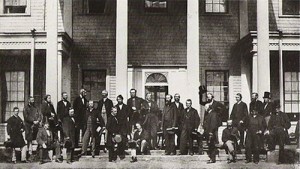
• Pay tribute to the Fathers of Confederation during Founder’s Week from Aug. 28-Sept. 8, which features concerts, fireworks and other activities.
• Get an inside look at the controversies for and against Confederation by visiting the Eptek Summer Celebrations from June until October.
• Attend the Summerside Highland Gathering, filled with Celtic gift shops, live Celtic music and different clan tents.
• If you’re interested in visiting Prince Edward Island, PEIJC tries to answer every email they receive through their website, peijc.org.
Vicky Tobianah is a multimedia writer, editor and strategist based in Toronto. Connect with her on Twitter, @vicktob, or by email at [email protected].




